The Bartender's Wardrobe: From Casual Cool to Classy Cocktails

Why Bartender Attire Matters More Than You Think
What does a bartender wear varies by venue, but the core elements are consistent: professional attire balancing style, comfort, and function. From all-black ensembles in cocktail lounges to branded shirts in pubs, bartenders typically wear:
- Tops: Collared shirts, button-downs, polos, or fitted t-shirts
- Bottoms: Dark dress pants, chinos, or well-fitted dark jeans
- Footwear: Non-slip, closed-toe shoes or boots
- Aprons: Canvas, denim, or leather with functional pockets
- Colors: Predominantly darker shades to hide spills and maintain a professional look
Bartenders are not just mixologists; they are visual representatives for their establishments. Your clothing choices directly impact customer perception, work performance, and personal confidence. A well-dressed bartender commands respect, moves efficiently, and represents the venue's brand identity.
The bartending world has evolved beyond the traditional white coat and bow tie. Today's bartenders range from casual cool to classy cocktail elegance. While each venue demands its own approach, the fundamentals of professional attire remain.
Modern bartender attire must solve real problems: hiding spills, allowing freedom of movement, and creating the right atmosphere. It's not just about looking good—it's about performing at your best while maintaining professional standards.
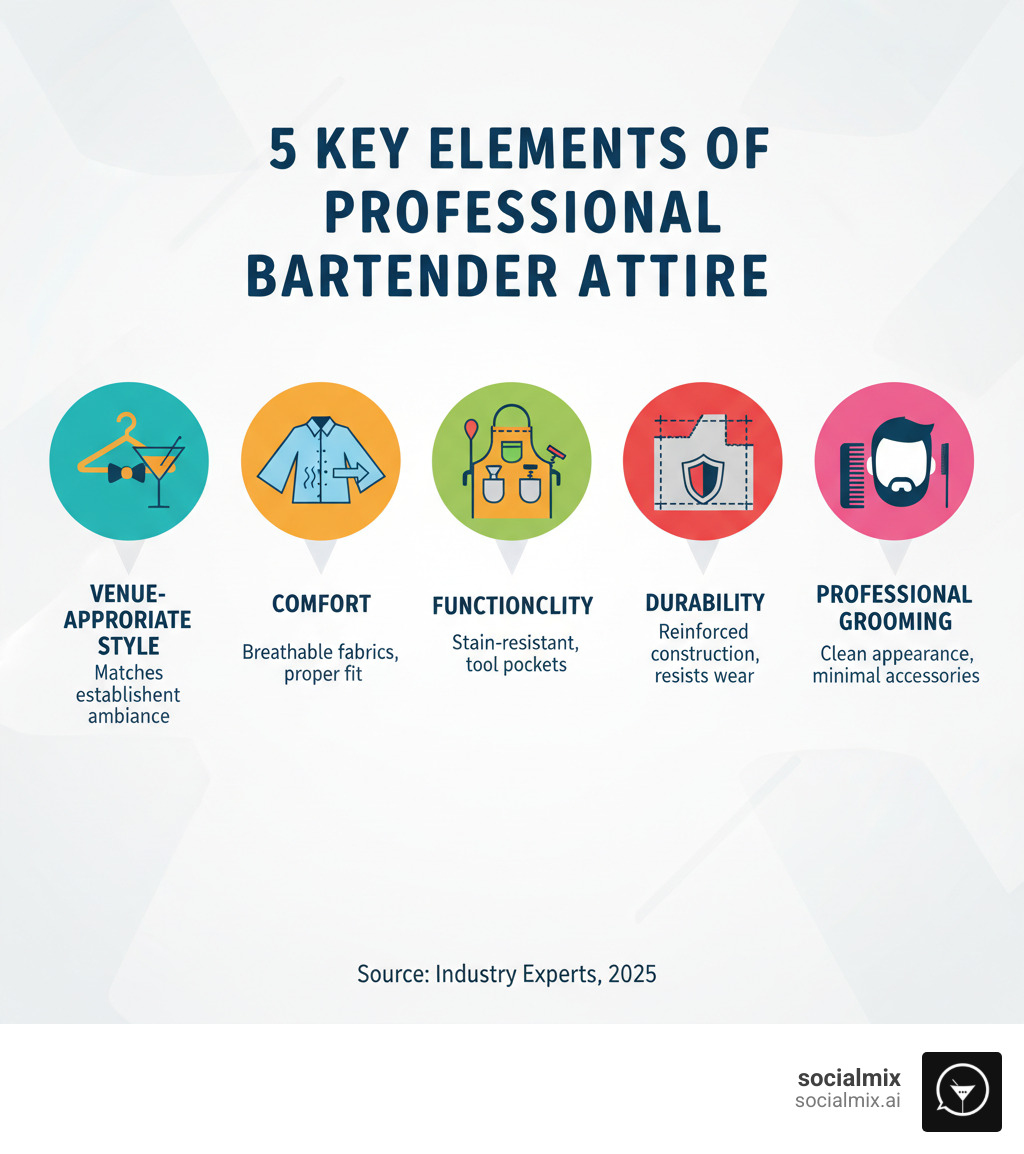
The Core Principles: Balancing Style, Comfort, and Functionality
When someone asks what does a bartender wear, they're asking about a uniform that works as hard as you do. You're on your feet for hours, reaching, bending, and dodging spills. Your outfit isn't just about looking good—it's about surviving your shift while remaining professional.
The smartest bartenders know their clothing affects their efficiency and how customers perceive them. At socialmix, we understand this balance. Our collections blend style with practicality, helping you feel confident and comfortable behind the bar.
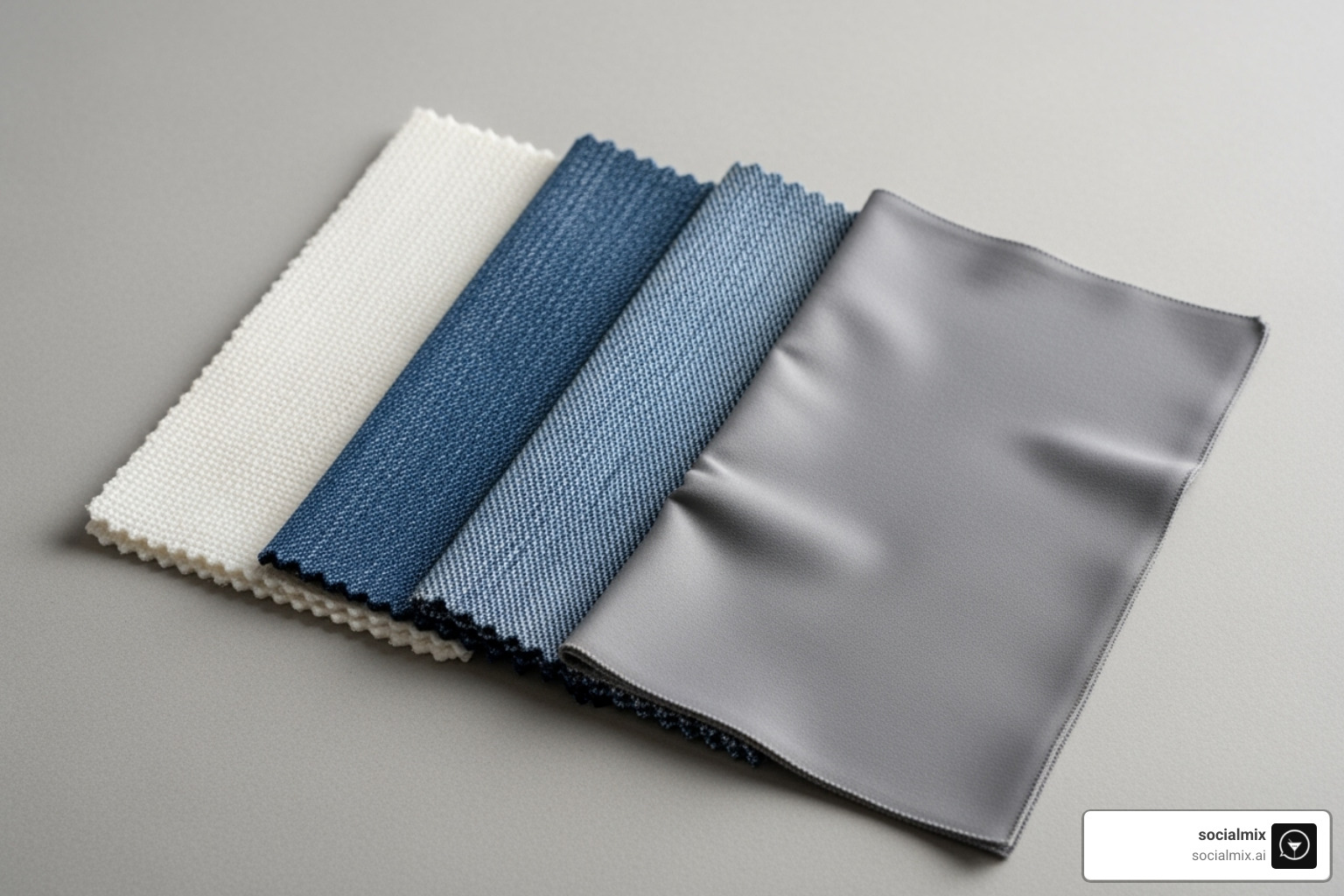
The three pillars of great bartender attire are comfort, functionality, and style. Master all three, and you'll feel ready for anything.
Comfort is King: Fabrics and Fit
Bartending is a physical job. Uncomfortable clothes make a long shift feel endless.
- Breathable fabrics like cotton blends and moisture-wicking synthetics are essential for staying cool.
- Stretch materials in shirts and pants provide the freedom of movement needed for reaching and squatting.
- The ideal fit is professional but loose enough for comfort. Avoid anything too tight or restrictive.
Proper fabrics also help with temperature regulation in a hot, crowded bar. Our practical guide to modern male bartender fashion trends dives deeper into choosing the right materials.
Functionality and Durability
Bartending is messy. Your clothes need to handle spills gracefully.
- Darker colors like black, navy, and deep burgundy are brilliant for hiding splashes and drips. They look professional and act as practical armor.
- Stain-resistant fabrics are a bonus, but dark materials naturally camouflage minor spills, letting you focus on your craft.
- Reinforced stitching in high-stress areas like shoulders and seams prevents wardrobe malfunctions during a busy shift.
- Functional pockets are essential for carrying tools like a wine key, pen, or bottle opener, keeping them accessible without getting in the way.
Style and Ambiance: Matching Your Look to the Venue
Your venue's personality should shine through in what does a bartender wear. You're part of the atmosphere.
- Upscale cocktail lounges may require vests, bow ties, or dinner jackets to create an air of sophistication.
- Casual pubs and sports bars work better with branded polos, fitted t-shirts, or dark jeans that feel approachable and fun.
- Themed establishments, like a speakeasy or tiki bar, allow for more creative, vintage, or tropical-inspired attire.
Brand consistency is key. A cohesive staff look signals professionalism and attention to detail. When in doubt, dress slightly more formally than you think is necessary. Our guide on raising the bar with timeless bartender attire for every occasion explores adapting your style to different venues.
Building Your Bartender Wardrobe: Essential Garments
Building a solid bartender wardrobe is like crafting a perfect cocktail—it's about the right mix of versatile pieces. When considering what does a bartender wear, think of your wardrobe as professional tools that help you look polished while handling a busy shift.
A well-planned wardrobe features quality staples that can transition from a casual pub to an upscale lounge. At socialmix, we believe clothing should improve social experiences. Our approach to Mens bartender uniforms that mix style and functionality reflects this, helping you connect with guests professionally.
The Foundation: Shirts and Tops
Your shirt is the foundation of your look.
- Button-down shirts are the gold standard, offering a crisp appearance that can be dressed up with a tie or down by rolling up the sleeves.
- Collared shirts, including polos, automatically lift your professional look. Banded collar shirts offer a neat alternative without requiring a tie.
- Well-fitted t-shirts and polos work for casual venues, especially with bar branding. "Well-fitted" is key—no old concert tees.
- Darker colors like black, navy, and dark green are best for hiding spills. A collection of black shirts is invaluable.
Our guide to The best bartender shirts for men: Stay stylish while you serve explores how the right shirt can boost your confidence.
The Bottom Line: Pants, Skirts, and Jeans
Your bottoms must balance comfort with professionalism.
- Dress pants and chinos in dark, stain-resistant fabrics are excellent investments, offering a smart look with flexibility.
- Dark-wash jeans can be appropriate in many venues, provided they are well-fitted and free of rips or distress.
- For female bartenders, skirts and dresses should have a modest length and allow for easy movement.
- As a general rule, avoid shorts unless they are part of a specific uniform, as they often lack a professional image.
The world of casual bar fashion offers plenty of options, as we explore in From chinos to jeans: Navigating casual bar fashion.
The Unsung Hero: The Bartender's Apron
The apron is a multitasking powerhouse combining protection, function, and style.
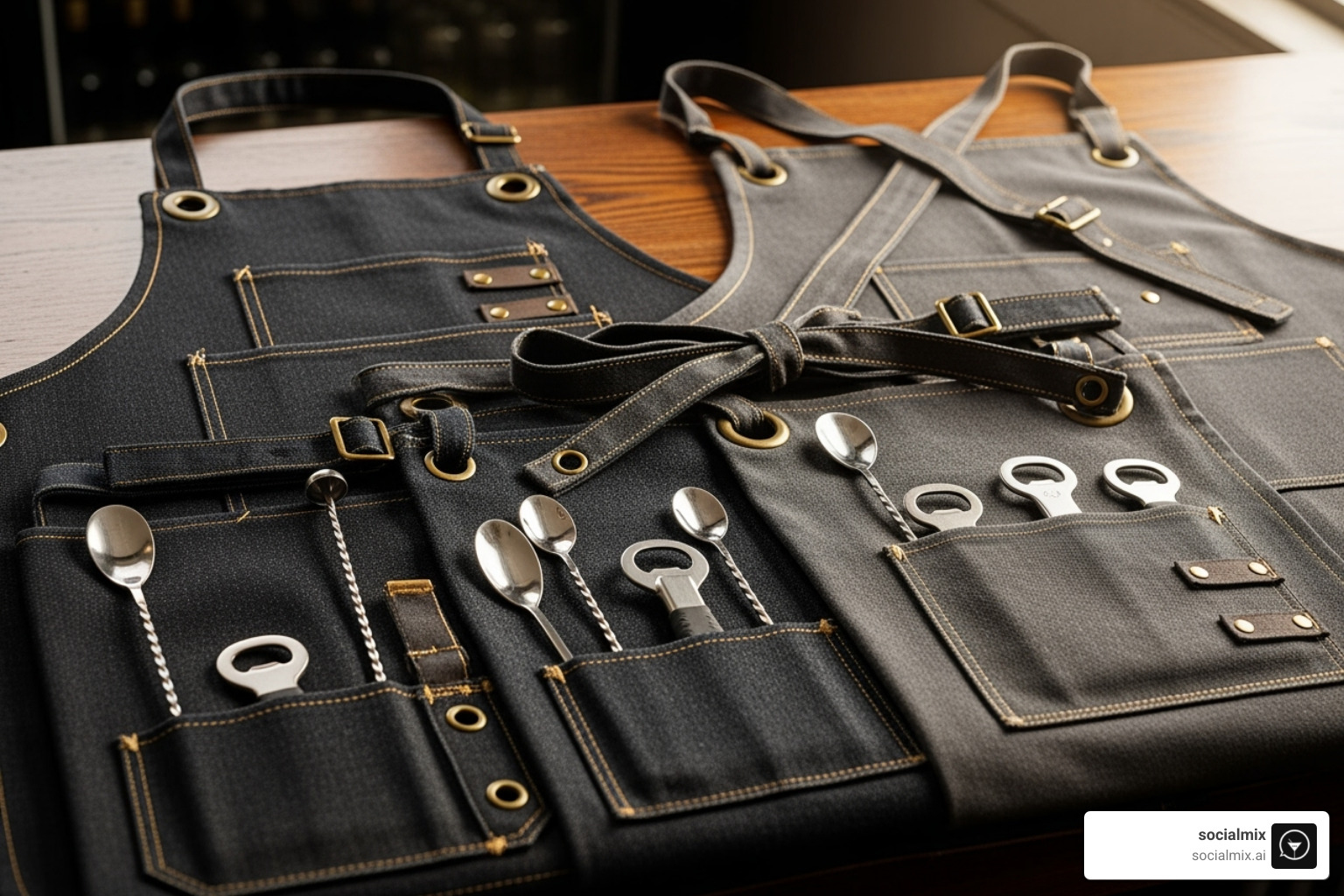
- Protection from spills is its primary job, acting as a first line of defense against splashes and drips.
- Pockets for tools are a game-changer, keeping wine keys, bottle openers, and pens within easy reach.
- Aprons are also powerful brand representation tools, showcasing a bar's logo, colors, or personality.
Today, the apron is a style statement. Durable canvas, artisanal denim, and sophisticated leather aprons add personality to your look. The right apron transforms from simple protective wear into an integral part of your professional identity, allowing you to maintain a polished appearance.
What Does a Bartender Wear? A Venue-by-Venue Guide
Understanding what does a bartender wear means adapting your style to different bar environments. This isn't just about rules; it's about reading the room and meeting customer expectations while staying comfortable.
At socialmix, we love how versatile bartending fashion can be. Our Raise the bar with these stylish bartending outfits collection celebrates this diversity. Let's explore what works where.
The Upscale Cocktail Lounge & High-Concept Bar
In an upscale lounge, the bartender's outfit is as carefully crafted as the cocktails. These venues demand formal attire that signals sophistication.
The classic look includes crisp button-down shirts paired with vests. Bow ties are timeless, but neckties also work. In the most refined establishments, you might see dinner jackets or tuxedos, like the iconic scarlet mess jackets at New York's Bemelmans Bar.
High-concept bars take creativity further, with uniforms like colored mechanic's jumpsuits or dusty rose pink dinner jackets that are part of the bar's artistic identity. For inspiration, check out our guide on 1920s bartender attire: Classic styles and inspirations.
The Casual Pub or Sports Bar
Casual pubs and sports bars have a relaxed dress code that prioritizes approachability. Professionalism still matters, but the vibe is comfortable.
Branded t-shirts and polos are common, often featuring the bar's logo. Pair these with dark jeans or chinos that are well-fitted and free from rips. The goal is an approachable look that makes customers feel at home.
Our Keep it chill and chic with these casual bar outfit ideas captures this balance of relaxed and refined.
The High-Energy Nightclub
Nightclub bartending requires stylish clothing that looks good under dramatic lights and allows freedom of movement.
Darker colors and all-black outfits are ideal, as they look sleek and hide spills in dim lighting. Many club bartenders opt for fashion-forward choices with interesting textures or modern cuts. The classic shirt-tie-and-vest combo also remains a winning choice, striking a balance between professional polish and evening sophistication. No matter the style, comfort is essential for performance during a high-volume shift.
Finishing Touches: Footwear, Accessories, and Grooming
While main garments form the foundation of what does a bartender wear, the finishing touches complete the professional look. Attention to footwear, accessories, and grooming is crucial for safety, efficiency, and creating a memorable experience.
What does a bartender wear on their feet?
This is arguably the most important part of the uniform for comfort and safety.
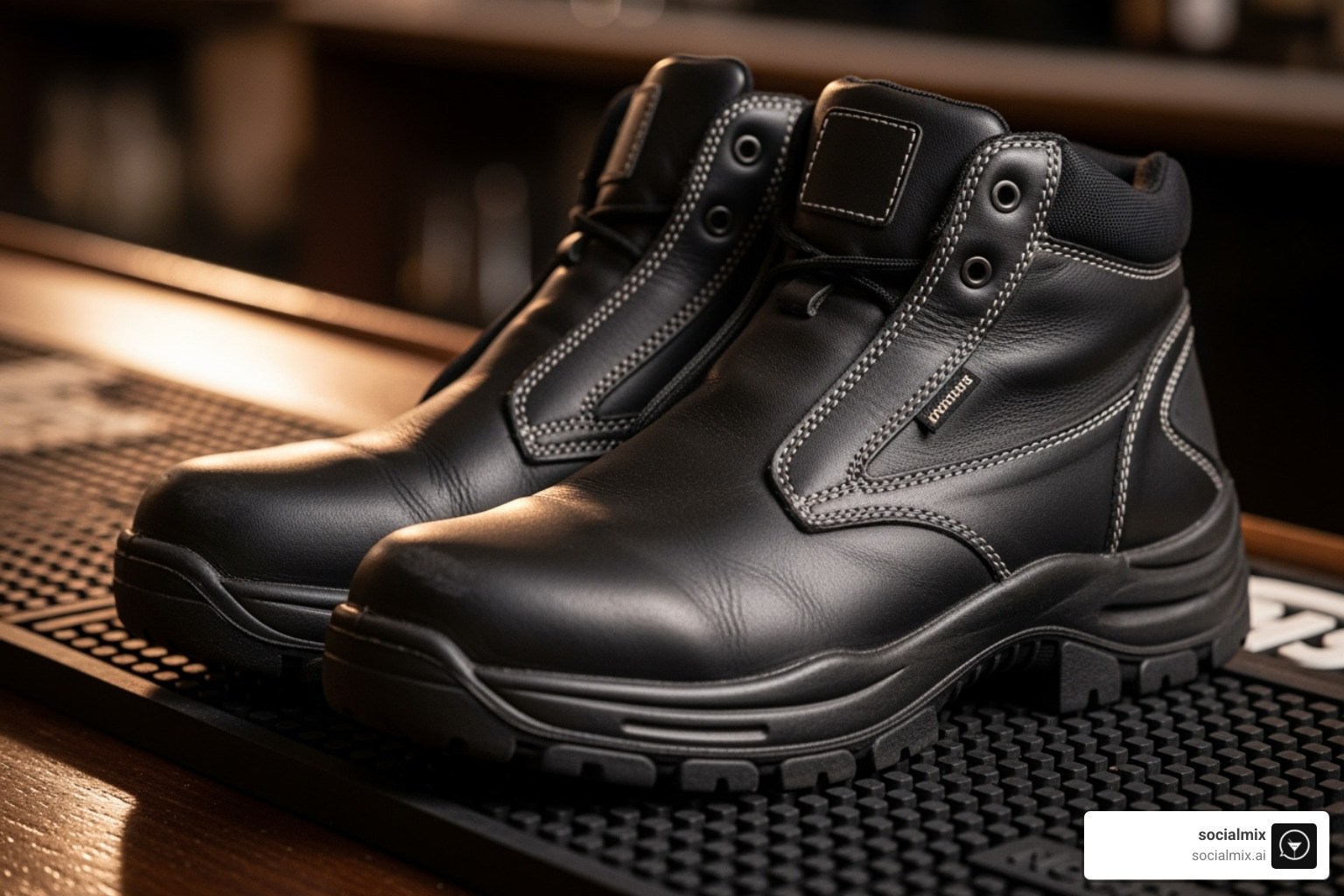
- Non-Slip Soles: Essential for preventing dangerous slips and falls on wet surfaces behind the bar.
- Comfort and Support: Cushioned insoles and good arch support are vital for long hours on your feet, preventing fatigue and back pain.
- Closed-Toe Shoes: A must for protecting feet from broken glass, falling objects, and spills.
- Boots: A popular choice for their durability, ankle support, and rugged aesthetic that fits many bar environments.
- Avoiding Heels: High heels are impractical and unsafe for long shifts. Flats or low-heeled, supportive shoes are better options.
What does a bartender wear for accessories?
For bartenders, accessories should be minimal and practical.
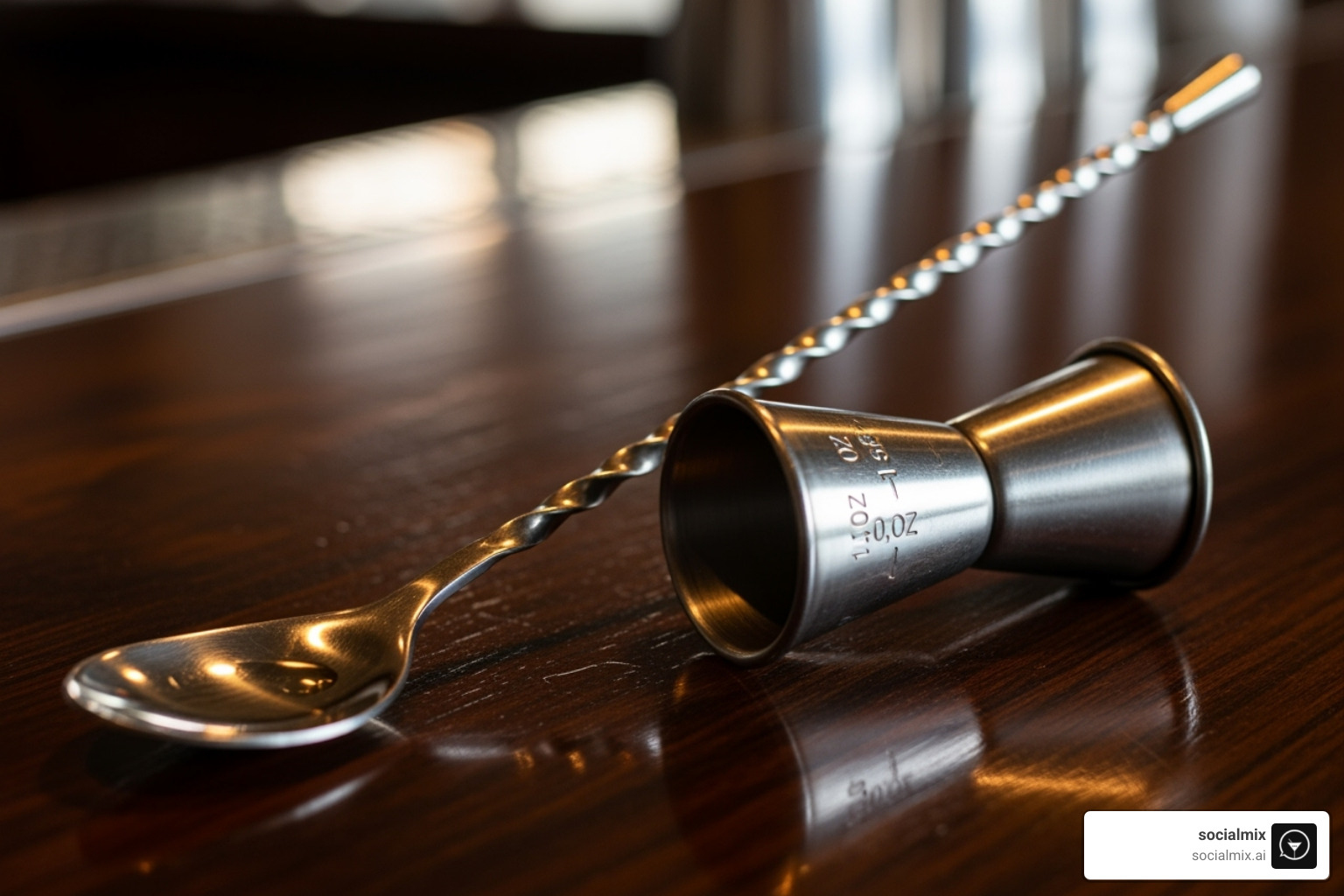
- Minimalism: The focus should be on the craft, not distracting bling.
- Practicality: A watch is useful for tracking orders. A tie clip keeps a tie neat and out of drinks.
- Lapel Pins: Small, tasteful pins can add personality or brand representation without being obtrusive.
- Avoiding Dangling Jewelry: Large earrings or long necklaces are a safety hazard, as they can snag on equipment or fall into drinks.
Our collection of essential alcohol accessories you need aligns with this philosophy of style meeting utility.
Beyond the Clothes: The Importance of Professional Grooming
Poor grooming can undermine a great outfit. Since bartenders are up close with guests, hygiene is paramount. A clean, professional appearance is non-negotiable.
- Clean Hair: Hair should be clean and styled appropriately. Longer hair should be tied back for practical and hygienic reasons.
- Groomed Nails: Hands are always visible, so nails must be clean and neatly trimmed.
- Minimal Fragrance: Strong perfumes or colognes can interfere with the aromas of drinks and be off-putting to guests. A subtle scent is best.
This attention to detail contributes to the perception of professionalism and ensures every guest interaction is positive.
Frequently Asked Questions about Bartender Attire
We've covered the essentials of what does a bartender wear, but some questions frequently arise. Here are the straight answers.
How have bartender uniforms evolved over time?
Bartender attire has evolved from clinical to creative. In the late 1800s and early 1900s, bartenders wore crisp white coats and bow ties, projecting an image of hygiene and professionalism. In upscale hotels, dinner jackets and tuxedos became the norm, a tradition that continues in some iconic bars today.
The modern era has seen a rise in creativity and personal style. High-concept bars now commission designer uniforms, from colored mechanic's jumpsuits to dusty rose pink dinner jackets. Today's uniform balances brand identity with individual expression. Our guide on 1920s bartender attire: Classic styles and inspirations dives into timeless looks that still inspire modern fashion.
What should a female bartender wear?
The principles of what does a bartender wear are universal, regardless of gender. Comfort, professionalism, and functionality are key for everyone.
Female bartenders need clothing that allows movement, hides spills, and looks sharp. Dark-colored dress pants or well-fitted dark jeans are excellent choices. For those who prefer skirts or dresses, appropriate lengths (knee-length or longer) that don't restrict movement are essential. The golden rule is to avoid overly revealing clothing, as it can detract from a professional image.
Our guide Shake up your look: Classy female bartender attire offers more specific inspiration for creating stylish, functional looks.
What are the pros and cons of a strict uniform versus allowing personal style?
This is a common debate in the industry. The best approach often depends on the venue's brand and goals.
| Feature | Strict Uniforms | Allowing Personal Style |
|---|---|---|
| Pros | - Brand Consistency: Creates a cohesive, professional look. - Professionalism: Conveys order and high standards. - Ease for Staff: No daily "what to wear" stress. |
- Boosts Morale: Allows for self-expression and confidence. - Showcases Personality: Adds character to the bar's atmosphere. - Authenticity: Can feel more genuine and less corporate. |
| Cons | - Restricts Individuality: Can feel stifling. - Can be Ill-fitting: Off-the-rack uniforms may be uncomfortable. - Cost: An expense for the establishment. |
- Risk of Unprofessionalism: Requires clear guidelines to avoid inappropriate attire. - Inconsistent Branding: Can create a disjointed look. - Potential for Conflict: Managers may need to address inappropriate choices. |
A hybrid approach often works best, providing core uniform pieces like a branded apron while allowing personal touches. This maintains brand consistency while letting bartenders' personalities shine through.
Conclusion: Shaking Up Your Style
From fabric choices to footwear, it's clear that what does a bartender wear is much more than just clothes—style is an extension of your craft. When you feel confident and comfortable, that energy radiates to every guest you serve. Your wardrobe is a professional tool, as essential as your jigger or bar spoon.
The core principles of comfort, functionality, and venue-appropriate style are the foundation that lets you focus on creating amazing drinks and memorable experiences. Today's bartenders are visual representatives of the bar, and your outfit reflects not just the bar's brand, but your own professional identity.
At socialmix, we're passionate about this intersection of style and craft. We believe that when you look good and feel comfortable, you're empowered to create unforgettable social moments.
Professionalism never goes out of style. Whether you're in a strict uniform or expressing personal flair, the fundamentals remain: be clean, comfortable, functional, and appropriate for your venue. Your wardrobe is waiting to help you shake up not just cocktails, but your entire professional presence.




Leave a comment